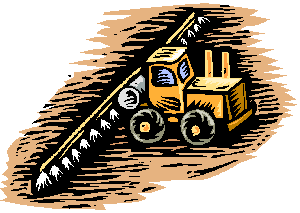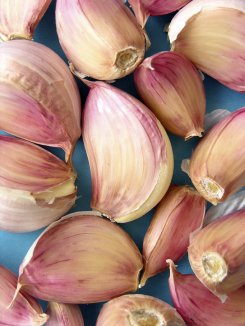

To send a message to an author, click on the author's name at the end of the article.
This Month in Ag Connection | Ag Connection - Other Issues Online
Wind storms late in the growing season of 2011 as well as fields that were flooded resulted in a lot of down corn in the area. The losses associated with the down corn and it's harvesting resulted in concerns over volunteer corn in next season's crop and the possible options to control it. Volunteer corn can be more than a nuisance and can result in yield losses in both corn and soybeans. Volunteer corn can also lead to significant corn rootworm problems. With soybeans, when rootworms hatch, they have nothing to eat. With volunteer corn, those rootworms have something to feed on and populations can build.

One of the most important factors to consider is what kind of corn was grown? Was the hybrid a conventional hybrid or did it have a single or multiple genetically -modified herbicide trait? The second factor is what crop do you intend to plant this coming spring? If you plant to rotate to a soybean crop [conventional, Round-up Ready, LibertyLink (LL) or STS], the simplest option would be to include a post-grass herbicide, such as Select Max, Assure II or Targa, in with the post herbicide program. However, other herbicide options could be used, depending on the type of soybean variety planted.
If you plan to rotate the field back to corn (corn on corn) then your options are a little more complex. If the volunteer corn has only the glyphosate (RR) trait, then a hybrid that is LibertyLink or Clearfield resistant will provide the best option for managing volunteer RR corn. More than likely, the volunteer corn problem will be stacked RR plus LL hybrid. With this combination of traits, the best bet would be to plant a Clearfield hybrid and spray with Pursuit or Lighting to help control or suppress the volunteer RR/SS corn. Another possible consideration would be to plant the problem field or fields last and allow the volunteer corn in the fallow field to germinate then spray with Select Max or possibly paraquat (Gramoxone) prior to planting. Select Max requires a 6-day wait before the corn crop can be planted and paraquat can be inconsistent and requires good spray coverage to be effective. Another possibility is tillage, whether it is moldboard tillage to bury the seed, spring tillage, or in-crop cultivation to provide some control of the volunteer corn between rows.
As new traits are available in corn hybrids, volunteer corn could become more of a problem. Once Enlist corn (Dow Agrosciences) and Optimum GAT corn (Dupont/Pioneer) are available in the market place, corn hybrids will have resistant combinations that could be tricky to manage as well.
Source: Wayne Crook, MU Extension Agronomy Specialist
This Month in Ag Connection | Ag Connection - Other Issues Online
One item often overlooked when using variable-rate technology (VRT) is the calibration of application equipment. Currently, no standard procedures exist for calibrating VRT. While calibration of spreaders, planters, and sprayers is needed for uniform application, it is even more critical to calibrate VRT controlled equipment. In a few cases, traditional calibration procedures will work but do not ensure proper operation over the expected range of varying application rates. The goal of calibration is to minimize application errors so target rates can be achieved with a certain level of confidence. The following suggestions cover how one should approach the calibration of equipment utilizing VRT.
VRT usually relies on either ground speed radar (GSR) or a global positioning system (GPS) receiver as input for actual ground speed. If a GSR is used, yearly calibration of this sensor is important so the variable-rate controller will properly adjust application rates with ground speed variations. An improperly calibrated GSR will lead to application errors. Follow either equipment or GSR manufacturers' recommendation for the proper calibration procedure.
Prior to calibration of equipment with VRT, one must determine the range of planned application rates for the product(s) to be used during VR application. This range will be used to ensure that the software and hardware setup will properly operate over the expected range of rates once an acceptable setup is determined during calibration. For example, one might decide to vary your corn seeding rates from 24K to 36K seeds/ac. With these parameters, select the median rate (30K) to start calibrating the planter equipped with VRT.
Pre-Calibration Checks

Make sure all hardware and software are in proper operating condition. Replace any worn hardware, especially those controlling the metering and distribution of material.
Specific Calibration Items to Consider
Information obtained from Alabama Cooperative Extension System - Timely Information Sheet: Calibrating Equipment with Variable-Rate Technology - https://sites.aces.edu/group/crops/precisionag/Publications/Timely%20Information/Calibrating%20Equipment%20with%20Variable-Rate%20Technology.pdf
Source: Kent Shannon, MU Extension Natural Resource Engineer Specialist
This Month in Ag Connection | Ag Connection - Other Issues Online
This article is continued from October 2011
Garlic has a relatively shallow root system and is sensitive to dry soil conditions. The amount of water to apply will depend on soil type. Irrigation is essential on sandy soils and may be beneficial in some years on finer textured soils. Soak the soil thoroughly when watering, to a depth of at least one inch each week during the growing season. The most critical stage for irrigation is during bulbing (mid-May to late June or early July). Lack of irrigation or rainfall during this stage will result in smaller bulbs and earlier maturity. Irrigation should be stopped about two weeks before harvest to avoid stained bulb wrappers and diseases.

For hardneck garlic, a decision needs to be made regarding scape removal. Yields can be reduced by 20% to 30% if the scape is allowed to mature. Yields are most affected in poorly fertilized soil, and only minimally (<5%) affected in high organic matter, well-fertilized soil. The time to remove the scape is just after the initiation of curling. The immature scapes are edible and considered a delicacy in some countries. They can be used in stir fries, salads, or steamed vegetables. There is some circumstantial evidence to suggest, however, that bulbs store better if the scape is left on until it turns woody. Scapes can be left on if a market for the bulbils is available to offset the loss in bulb yield. More mature scapes are sometimes used in flower arrangements.
Garlic is a poor competitor with weeds. Weeds are best controlled through the combination of hand hoeing, pulling and mulching. The roots of garlic are very close to the surface of the soil, so it is important not to cultivate too deeply. Cultivate just deeply enough to cut the weeds off below the surface of the soil. Be careful not to damage the plants when cultivating.
Leaving the straw mulch in place will greatly reduce weed pressure. If mulch is removed in the spring to allow the soil to warm up, a thorough, shallow cultivation before reapplying straw mulch will keep down annual weed populations. Be sure to use straw free of weed seed as mulch.
Harvesting too early will result in small bulbs, and harvesting too late will result in cloves popping out of bulbs. Depending on variety and climate zone, garlic is normally harvested between late June and late July. One indication to start harvesting is when the lower leaves turn brown and when half or slightly more than half of the upper leaves remain green. Alternatively, you can pull a few bulbs and cut them in half; if the cloves fill the skins, then the bulbs are ready to harvest.
Harvest plants with shoots and bulbs attached. Knock off any large clumps of soil, and then put the plants in a warm, dry, airy place for 3-4 weeks to cure. This will dry the sheaths surrounding the bulbs, as well as the shoots and roots. After curing, the shoots can be cut ½ - 1 inch above the bulbs and the roots trimmed close to the bulb base.
Garlic cloves can easily be saved from one crop to the next. It is recommended to keep the biggest one for planting the following year.
Optimum storage conditions will depend on whether the garlic is to be used for table stock or planting stock.
Table stock garlic is best stored at 32° to 40°F and a relative humidity of 60% to 70%. Table stock garlic also can be stored at room temperature and 60% to 70% relative humidity, but will dehydrate faster than if stored at 32° to 40°F. Softneck garlic typically can be stored for six to eight months at room temperature, while hardneck garlic usually starts to deteriorate after about three to four months.
At 32°F, hardneck garlic can be stored for up to seven months without significant dehydration. Temperatures between 42° and 52° Fahrenheit will cause sprouting, and humidity greater than 70% tends to promote rooting.
Planting stock garlic should be stored at room temperature and 60% to 70% relative humidity.
Insects- Insects are not a major problem with garlic, although onion maggot is a potential pest. Onion maggots bore into plant stems, causing the plants to turn yellow and wilt.
Disease- Garlic is susceptible to several types of rot, Fusarium basal rot being the most common. To avoid these diseases plant only healthy cloves, manage weeds in the garden, and take care not to injure garlic bulbs while working in the garden. Plant garlic in an area where no onions, chives, leeks, shallots or garlic have been planted for the past 4 years.
The authors would like to recognize the article 'Growing Garlic in Minnesota' by University of Minnesota Extension for substantial use of content.
Source: James Quinn, MU Extension Horticulture Specialist and Parman Green, MU Extension Ag Business Specialist
This Month in Ag Connection | Ag Connection - Other Issues Online
Publishing Information
Ag Connection is published monthly for Northeast and Central areas of Missouri producers and is supported by the University of Missouri Extension, the Missouri Agricultural Experiment Station, and the MU College of Agriculture, Food and Natural Resources. Managing Editor: Mary Sobba.